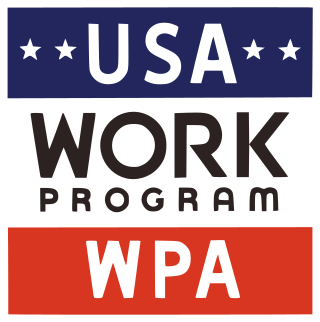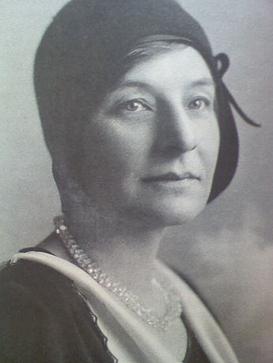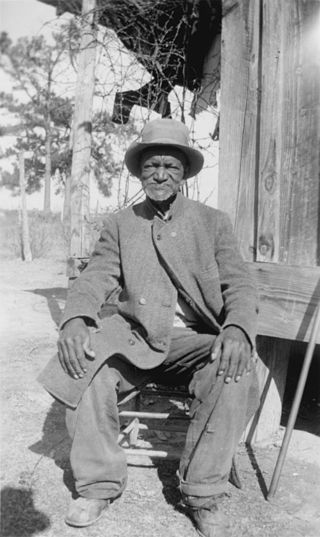Related Research Articles

The Works Progress Administration was an American New Deal agency that employed millions of jobseekers to carry out public works projects, including the construction of public buildings and roads. It was set up on May 6, 1935, by presidential order, as a key part of the Second New Deal.

Wallace Earle Stegner was an American novelist, short story writer, environmentalist, and historian, often called "The Dean of Western Writers". He won the Pulitzer Prize in 1972 and the U.S. National Book Award in 1977.

The Federal Writers' Project (FWP) was a federal government project in the United States created to provide jobs for out-of-work writers, launched in 1935 during the Great Depression. It was part of the Works Progress Administration (WPA), a New Deal program. It was one of a group of New Deal arts programs known collectively as Federal Project Number One or Federal One.

Federal Project Number One, also referred to as Federal One, is the collective name for a group of projects under the Works Progress Administration, a New Deal program in the United States. Of the $4.88 billion allocated by the Emergency Relief Appropriation Act of 1935, $27 million was approved for the employment of artists, musicians, actors and writers under the WPA's Federal Project Number One. In its prime, Federal Project Number One employed up to 40,000 writers, musicians, artists and actors because, as Secretary of Commerce Harry Hopkins put it, "Hell, they’ve got to eat, too". This project had two main principles: 1) that in time of need the artist, no less than the manual worker, is entitled to employment as an artist at the public expense and 2) that the arts, no less than business, agriculture, and labor, are and should be the immediate concern of the ideal commonwealth.

The Federal Emergency Relief Administration (FERA) was a program established by President Franklin D. Roosevelt in 1933, building on the Herbert Hoover administration's Emergency Relief and Construction Act. It was replaced in 1935 by the Works Progress Administration (WPA).

The Historical Records Survey (HRS) was a project of the Works Progress Administration New Deal program in the United States. Originally part of the Federal Writers' Project, it was devoted to surveying and indexing historically significant records in state, county and local archives. The official mission statement was the "discovery, preservation, and listing of basic materials for research in the history of the United States". The creation of the Historical Records Survey was one of the signal events "in what Solon Buck called the 'archival awakening' of the 1930s".
The Federal Art Project (1935–1943) was a New Deal program to fund the visual arts in the United States. Under national director Holger Cahill, it was one of five Federal Project Number One projects sponsored by the Works Progress Administration (WPA), and the largest of the New Deal art projects. It was created not as a cultural activity, but as a relief measure to employ artists and artisans to create murals, easel paintings, sculpture, graphic art, posters, photography, theatre scenic design, and arts and crafts. The WPA Federal Art Project established more than 100 community art centers throughout the country, researched and documented American design, commissioned a significant body of public art without restriction to content or subject matter, and sustained some 10,000 artists and craft workers during the Great Depression. According to American Heritage, “Something like 400,000 easel paintings, murals, prints, posters, and renderings were produced by WPA artists during the eight years of the project’s existence, virtually free of government pressure to control subject matter, interpretation, or style.”

The Black Cabinet, or Federal Council of Negro Affairs or Black Brain Trust, was the informal term for a group of African Americans who served as public policy advisors to President Franklin D. Roosevelt and First Lady Eleanor Roosevelt in his terms in office from 1933 to 1945. Despite its name, it was not an official organization. The term was coined in 1936 by Mary McLeod Bethune and was occasionally used in the press. By mid-1935, there were 45 African Americans working in federal executive departments and New Deal agencies.

Paradise Valley is a census-designated place (CDP) in Humboldt County, Nevada, United States, near the Santa Rosa Ranger District of Humboldt National Forest. It is located at the northern terminus of Nevada State Route 290, about 19 miles (31 km) northeast of U.S. Highway 95 and a total of 40 miles (64 km) north of Winnemucca. The town is located in a broad valley, with the Santa Rosa Range of mountains just to the northwest. At the 2010 census, the population of the CDP was 109.

Michigan State University Libraries is the academic library system of Michigan State University in East Lansing, Michigan, United States. The library system comprises nine branch locations including the Main Library. As of 2015-16, the MSU Libraries ranked 26th among U.S. and Canadian research libraries by number of volumes and 11th among U.S. and Canadian research libraries by number of titles held.
In social science, foodways are the cultural, social, and economic practices relating to the production and consumption of food. Foodways often refers to the intersection of food in culture, traditions, and history.

The American Guide Series includes books and pamphlets published from 1937 to 1941 under the auspices of the Federal Writers' Project (FWP), a Depression-era program that was part of the larger Works Progress Administration in the United States. The American Guide Series books were compiled by the FWP, but printed by individual states, and contained detailed histories of each of the then 48 states of the Union with descriptions of every major city and town. The series not only detailed the histories of the 48 states, but provided insight to their cultures as well. In total, the project employed over 6,000 writers. The format was uniform, comprising essays on the state's history and culture, descriptions of its major cities, automobile tours of important attractions, and a portfolio of photographs.

The Detroit Naval Armory is located at 7600 East Jefferson Avenue in Detroit, Michigan. It is also known as the R. Thornton Brodhead Armory. The armory was designated a Michigan State Historic Site in 1980 and listed on the National Register of Historic Places in 1994.

Grace Stone Coates (1881–1976) wrote short stories, poetry, and news articles. She did most of her writing out of her home in Martinsdale, Montana. Coates published her first poem, "The Intruder", in 1921 and her first series of linked stories, Black Cherries, in 1931. She co-edited and wrote for Frontier, a literary magazine edited by Harold G. Merriam, a creative writing professor at the University of Montana.

Todros Geller was a Jewish American artist and teacher best known as a master printmaker and a leading artist among Chicago's art community.

Slave Narratives: A Folk History of Slavery in the United States is a collection of histories by formerly enslaved people undertaken by the Federal Writers' Project of the Works Progress Administration from 1936 to 1938. It was the simultaneous effort of state-level branches of FWP in seventeen states, working largely separately from each other. FWP administrators sought to develop a new appreciation for the elements of American life from different backgrounds, including that from the last generation of formerly enslaved individuals. The collections of life histories and materials on African American life that resulted gave impetus to the collection.

Ruby Pickens Tartt was an American folklorist, writer, and painter who is known for her work helping to preserve Southern black culture by collecting the life histories, stories, lore, and songs of former slaves for the Works Progress Administration and the Library of Congress. In 1980 she was inducted into the Alabama Women's Hall of Fame.

Henry Garfield Alsberg was an American journalist and writer who served as the founding director of the Federal Writers' Project.
William Meredith Cunningham (1901-1967) was an acclaimed Oklahoma writer of the 1930s, involved in the Works Progress Administration's Federal Writer's Project, and was a supporter of the American Socialist Party.

Cavalcade of the American Negro is a grouping of related artworks collaboratively created by employees of the WPA-funded Illinois Writers' Project and the Federal Art Project for the 1940 American Negro Exposition, a world's fair-style event celebrating the 75th anniversary of the Emancipation of enslaved people in the United States.
References
- ↑ Jankowski, Nicole (2016-10-22). "The Grand, Unfinished Task Of Chronicling How America Eats". NPR. Retrieved 2021-11-17.
- ↑ "About | What America Ate". whatamericaate.org. Retrieved 2021-11-17.
- ↑ "Federal Writers' Project: New Deal Web Guide (Virtual Programs & Services, Library of Congress)". www.loc.gov. Retrieved 2022-01-19.
- ↑ "Single Explore Essay | What America Ate". whatamericaate.org. Retrieved 2022-01-19.
- ↑ "Northeast Region Correspondence | What America Ate". whatamericaate.org. Retrieved 2022-01-19.
- ↑ "Instructions for the Louisiana Writers' Project | What America Ate". whatamericaate.org. Retrieved 2022-01-19.
- ↑ "Middle West Region Correspondence | What America Ate". whatamericaate.org. Retrieved 2022-01-19.
- ↑ "Far West Region Correspondence | What America Ate". whatamericaate.org. Retrieved 2022-01-19.
- ↑ "Southwest Region Correspondence | What America Ate". whatamericaate.org. Retrieved 2022-01-19.
- ↑ "Home | What America Ate". whatamericaate.org. Retrieved 2022-01-24.